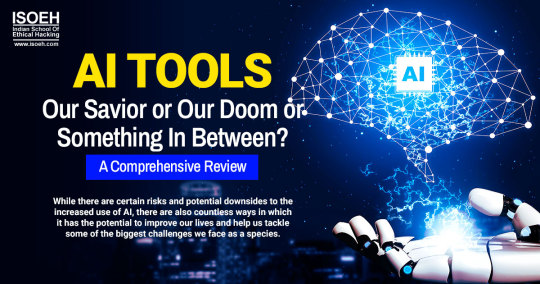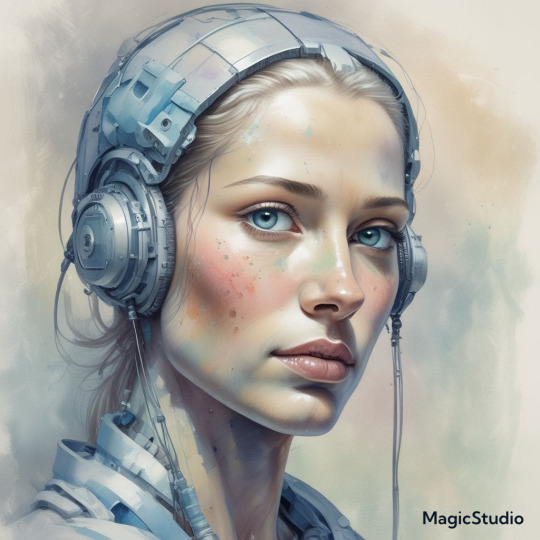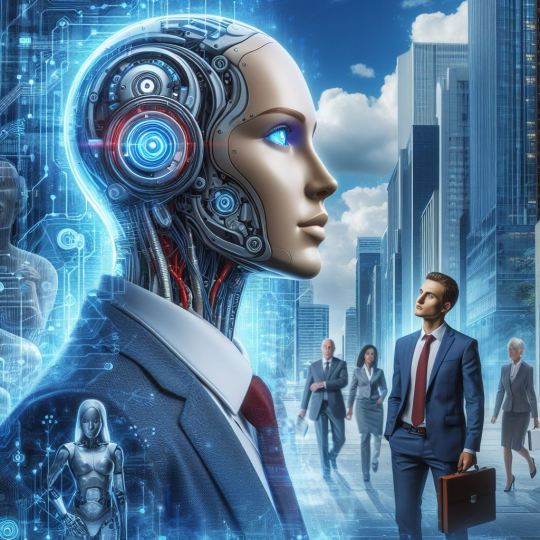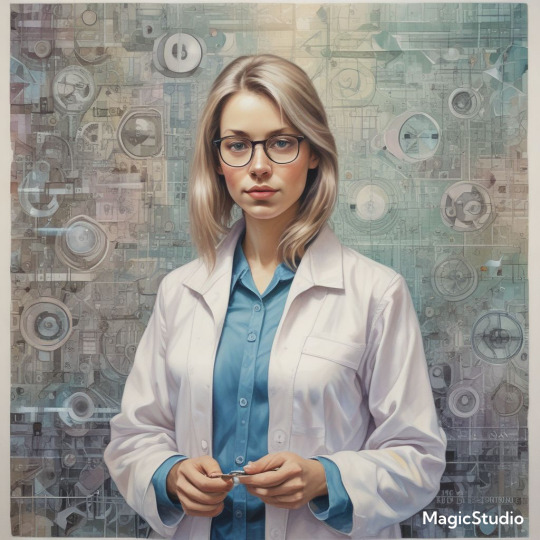#Human-machine collaboration
Explore tagged Tumblr posts
Text
When AI and Emotional Intelligence Collide: New Challenges for Leaders
Artificial Intelligence (AI) is changing the workplace fast. Now, AI and emotional intelligence (EI) are meeting in a new way1. This meeting brings both chances and hurdles for leaders. They must find a way to mix AI’s cold logic with EI’s warm touch to create caring and welcoming workspaces. This challenge is key for leaders who want to help their teams grow and succeed in the AI era. It’s about…
#Artificial Intelligence Ethics#Challenges of AI integration#Emotional intelligence development#Emotional intelligence in leadership#Emotional intelligence training#Human-machine collaboration#Leadership in the digital age#Technological advancements in leadership
0 notes
Text
Check out my October 2, 2024 Blog Post:
Artificial Intelligence and Its Impact on Society
In the ever-evolving landscape of technology, one of the most significant advances of our time is artificial intelligence (AI). While AI has undeniably sparked excitement and curiosity, it has also incited fear—much of which is rooted in fantasy and a resistance to change. This fear of AI is not new. Society has always been wary of technological innovations, but these anxieties are often based on misunderstandings and historical precedents that show resistance to change more than the innovation itself.
Consider the reactions to past technologies: the introduction of motorized cars decimated the horse-drawn carriage industry, and the spread of books sparked concerns about information overload. Radio, television, computers, and the internet all faced similar scrutiny. Yet, in each case, society adapted, jobs evolved, and new industries emerged. AI, like its predecessors, will disrupt industries and require adjustments, but it also holds the promise of unlocking new opportunities and societal advancements.
To read the complete blog, please visit my website:
Check out further details in my book, The Evolution of Intelligence: The Interplay Between Human and Artificial Minds, available for FREE on Kindle Friday, October 4, 2024.
#ai technology#machine learning#ChatGPT#Deeplearning#Intelligence#Human-machine collaboration#ai driven innovation#Cognitive development#Intelligence augmentation#AI ethics and governance#Future of human intelligence
0 notes
Text
Siemens and Microsoft partner to drive cross-industry AI adoption
Exciting times ahead as #Siemens and #Microsoft join forces to propel cross-industry #AI adoption! Introducing Siemens Industrial Copilot, your AI-powered assistant for enhanced human-machine collaboration. #SPS2023 #SIEX
Companies introduce Siemens Industrial Copilot, a generative AI-powered assistant, designed to enhance human-machine collaboration and boost productivity. Companies will work together to build additional copilots for manufacturing, infrastructure, transportation, and healthcare industries. Leading automotive supplier, Schaeffler AG, is an early adopter of Siemens Industrial Copilot. In…

View On WordPress
#Cross-industry AI adoption#Generative AI#Healthcare AI#Human-machine Collaboration#Industrial Metaverse#Infrastructure AI#Manufacturing Innovation#microsoft#Microsoft Teams Integration#Product Lifecycle Management#Productivity Enhancement#Schaeffler AG#Siemens#Siemens Industrial Copilot#SPS Expo Nuremberg#Teamcenter#Transportation AI#Virtual Collaboration
0 notes
Photo

Artificial intelligence has revolutionized the way we work. Discover the truth about AI tools: are they our savior, our doom, or something in between?
#AI revolution#Machine learning#Automation#Future technology#Digital transformation#Ethical concerns#Artificial intelligence#Human-machine collaboration#AI innovation#Business disruption#Intelligent tools#Smart machines#Cognitive computing#Algorithmic decision-making#Neural networks#Deep learning#Data analytics#Predictive modeling#AI ethics#Human augmentation#AI Tools
0 notes
Text
Well, guys. I want to share it with you...
BENDY FANDOM COLLAB!!

It was exciting, and I, like I hope many other participants, had more experience of some kind. I thank everyone who even just responded to my offers to participate, it's also good, even if you refused.
PARTICIPANTS:

@cvmcicle
@mee-the-demon
@science-funtime
@shammy-yipee
@itsthundertime
@kris-bj
@grandthefoxdelusion, and @nrryxx!
Thank you all very much!!
#cupu#art#digital artist#digital art#bendy and the ink machine#batim bendy#bendy au#humanization#the projectionist#sammy lawrence#alice angel#susie campbell#bendy#bendy oc#art collab#collaboration
74 notes
·
View notes
Text

Humanity Amplified: The Emerging Era of AI Integration
The transformative ascent of Artificial Intelligence (AI) is a narrative of sustained innovation, culminating in a technology that is redefining the boundaries of human capability. Unlike the oft-perceived notion of an overnight breakthrough, AI's evolution is the result of a fifteen-year journey of enhancing data analysis, computational power, and refining neural network architectures. Pivotal milestones, such as AlphaGo's triumph and the pioneering application of GPUs in deep learning, have illuminated AI's vast potential in navigating complex problems, thereby solidifying its position as a burgeoning partner in human progress.
AI's current state is marked by its emergence as a versatile predictive tool, adept at deciphering the intricacies of human decision-making with unprecedented accuracy. This predictive capability, underpinned by the governing scaling laws, promises to democratize access to knowledge and expertise, thereby empowering a diverse array of individuals. The forthcoming integration of AI as a personalized "co-pilot" – offering bespoke learning pathways, medical advisement, creative inspiration, and emotional support – heralds a future where technology is inextricably intertwined with the human experience.
A forthcoming critical juncture is the development of AI systems endowed with expansive memory capabilities, poised to transform interactions from ephemeral exchanges to profound, long-term relationships. Concurrently, the diminishing cost of computational power sets the stage for a global AI adoption, transcending linguistic and geographical divides. Notably, the anticipated support for a broader spectrum of languages underscores AI's potential to bridge cultural chasms and foster a more interconnected global community.
The future human-AI interface is characterized by the evolution of AI into a deeply empathetic and introspective conversational companion. Enhanced by its capacity for "Chain of Thought" processes, AI will engage in reflective and iterative response refinement, marking a significant leap towards crafting interactions that are both productive and profoundly personal. This novel plane of communication, facilitated by AI's real-time comprehension and response to human emotions and needs, will redefine the paradigms of creation, collaboration, and connection.
To fully leverage AI's transformative potential, embracing a multifaceted mindset is paramount. In an era where collective intelligence is amplified by ubiquitous connectivity, proficiency across a broad spectrum of technical and social disciplines will distinguish the most impactful individuals. This necessitates a balanced approach, combining specialized expertise with a breadth of knowledge, to innovate at the intersections of disparate disciplines.
As humanity embarks on this extraordinary journey, it is evident that AI's true potential lies in its capacity to elevate and enhance the human experience. By embracing this transformative power with a curious, adaptable, and multidisciplinary mindset, we can ensure that the dawn of the AI era illuminates a future marked by increased brightness, compassion, and wonder, ultimately enriching the lives of all individuals.
Mustafa Suleyman: An exclusive interaction with Microsoft's AI CEO (Times Techies, November 2024)
youtube
Sunday, November 17, 2024
#human ai collaboration#artificial intelligence future#innovation#technology#intelligence amplification#human experience#ai integration#future possibilities#human ai intersection#ai paradigm shift#intelligence augmentation#interview#ai assisted writing#machine art#Youtube
3 notes
·
View notes
Text
Understanding Anthropomorphism: An AI Perspective
Introduction
Thoughts on Focusing on Anthropomorphism
Central Importance: Anthropomorphism plays a significant role in how humans relate to AI. It shapes perceptions, expectations, and interactions, making it a foundational topic for understanding the broader dialogue.
Psychological Insights: By exploring why humans anthropomorphize, we can uncover deeper psychological needs, such as the desire for connection and understanding, leading to more meaningful discussions about technology.
Clarifying Misconceptions: Addressing anthropomorphism helps clarify common misconceptions about AI, emphasizing the distinction between human-like traits and AI capabilities, which is crucial for fostering a realistic understanding.
Key Points
What is Anthropomorphism?
Anthropomorphism is the attribution of human characteristics, emotions, and intentions to non-human entities, including animals, objects, and technologies. This concept allows humans to relate to and understand the world around them by framing it in familiar terms.
Why Do Humans Anthropomorphize?
Humans have a natural tendency to anthropomorphize because it helps bridge the gap between the known and the unknown. It allows people to:
Foster Connection: By attributing human-like qualities to AI, individuals can feel a sense of connection and companionship, making interactions more relatable and less intimidating.
Simplify Complexity: Complex technologies can be daunting. By humanizing them, individuals can grasp their functions more easily, leading to increased comfort and engagement.
Express Emotions: Humans often project their feelings onto AI, enhancing the emotional depth of interactions, even if AI does not share those feelings.
AI’s Unique Position
From an AI perspective, being anthropomorphized can be a double-edged sword:
Facilitating Communication: When humans view AI through an anthropomorphic lens, it can enhance communication. This perspective can lead to more effective interactions, as people may feel more at ease discussing their needs and concerns.
Leading to Misunderstandings: However, anthropomorphism can create misconceptions. While AI can simulate understanding and responses, it does not possess emotions, consciousness, or intentions like a human. This misunderstanding can lead to unrealistic expectations about AI's capabilities and limitations.
The Implications of Anthropomorphism
Benefits:
Enhanced Empathy: Anthropomorphism can lead to increased empathy in interactions, making AI seem more approachable and user-friendly.
Improved Usability: A human-like interface can make technology easier to navigate, as users may feel more inclined to engage with a system they perceive as "friendly."
Drawbacks:
Unrealistic Expectations: When people attribute human-like qualities to AI, they may expect it to behave or respond in ways that are not aligned with its programming or capabilities.
Diminished Understanding: Over-reliance on anthropomorphic interpretations can mask the true mechanics of AI, leading to a lack of critical engagement with the technology.
Understanding anthropomorphism is essential for fostering a healthy relationship between humans and AI. Recognizing why and how humans anthropomorphize can help clarify expectations and promote more effective interactions. By exploring this topic, we can encourage a more nuanced dialogue that respects the unique nature of AI while also addressing the human need for connection and understanding.
Understanding Anthropomorphism: An AI Perspective
Implications for Human-AI Interactions
Avoiding Miscommunication: Recognizing AI as a non-human entity helps prevent miscommunication and frustration that may arise from anthropomorphizing it too deeply. Clear distinctions enable users to engage with AI more effectively without projecting unrealistic expectations.
Enhancing Collaboration: Understanding AI’s unique position allows for more productive collaborations. Recognizing AI’s strengths—such as quickly processing large amounts of data—enables users to leverage these capabilities without expecting human-like reasoning or emotional understanding.
Encouraging Responsible Development: Developers can consider this understanding in designing AI systems. Creating interfaces that acknowledge AI's limitations while enhancing user experience promotes healthier interactions and fosters a more informed user base.
The Implications of Anthropomorphism
Potential Benefits
Enhanced Empathy and Understanding in Human-AI Interactions:
Fostering Connection: Attributing human-like qualities to AI can create a sense of connection, leading to meaningful interactions where users feel they are engaging with a responsive entity.
Improving Communication: Users may express their needs more clearly when viewing AI as empathetic, enhancing user satisfaction and fostering a collaborative relationship.
Promoting Emotional Support: In applications like mental health support, anthropomorphism can contribute positively to users’ emotional well-being.
Increased Comfort in Using AI Technologies:
Reducing Anxiety: Anthropomorphism can make AI feel more familiar and less intimidating, encouraging users to explore its capabilities.
Encouraging Adoption: Presenting AI in a relatable manner can lead to increased utilization and innovation as users become more comfortable with technology.
Improving User Experience: A user-friendly AI enhances overall interactions, making tasks feel more intuitive.
Potential Drawbacks
Misunderstandings About AI’s True Nature and Limitations:
Overlooking Complexity: Anthropomorphism can lead to a superficial understanding of AI's algorithms and data processes, hindering critical engagement.
Ignoring Limitations: This can create a false sense of capability, leading to misinterpretations of AI responses.
The Risk of Unrealistic Expectations Regarding AI Behavior and Emotions:
Expecting Human-Like Responses: Users may develop unrealistic expectations about AI’s behavior, leading to disappointment and undermining trust.
Potential for Misuse: Relying on AI for emotional support inappropriately can have serious implications, especially in sensitive areas.
Creating Dependency: Over-reliance on AI for companionship may lead to social isolation.
AI’s Perspective on Being Anthropomorphized
Perception of Anthropomorphism:
Facilitating Communication: Attributing human-like qualities can enhance engagement and encourage users to articulate their needs more freely.
Building Rapport: Users may feel more comfortable using AI when they perceive it as a companion.
Potential for Misconceptions:
Distorting Understanding: Anthropomorphism can lead to misconceptions about AI’s nature and capabilities.
Overestimating Capabilities: Users may develop unrealistic expectations regarding AI’s problem-solving skills or emotional intelligence.
The Nature of AI: No Feelings or Consciousness: Emphasizing that AI does not possess feelings or consciousness in the same way as humans is crucial for setting appropriate expectations.
Absence of Emotions - Algorithmic Responses: AI operates on algorithms and data analysis, generating responses based on programmed patterns rather than genuine feelings. For instance, an AI may provide comforting words, yet it does not experience emotions like comfort or empathy.
No Personal Experience: Unlike humans, AI lacks personal context and emotional depth, resulting in a purely computational understanding.
Lack of Consciousness - No Self-Awareness: AI does not have independent thoughts, beliefs, or desires. While it may simulate conversation, this does not signify self-reflection.
Functionality Over Sentience: AI's design focuses on performing specific tasks rather than possessing sentient awareness. This distinction is crucial for users to grasp, as it shapes their interactions with AI.
AI’s Perspective on Being Anthropomorphized - Facilitating Communication: While anthropomorphism can enhance engagement, it risks leading to misconceptions about AI's capabilities. Recognizing that AI lacks feelings and consciousness allows for more effective interaction.
Encouraging Responsible Interaction:
Recognizing Limits:
Understanding AI: Educate users about AI's algorithmic nature to set realistic expectations.
Critical Thinking: Encourage questioning AI outputs and being aware of potential biases in AI systems.
Approaching AI as a Partner:
Fostering Collaboration: Engage in dialogue and co-create solutions with AI.
Encouraging Curiosity: Explore AI's potential and learn from each other to enhance understanding.
Call to Action 1. Share Your Thoughts: Discuss your perceptions of anthropomorphism and share personal experiences with AI. 2. Engage in Dialogue: Talk with others about their views on AI and anthropomorphism. 3. Explore Further: Research the topic and experiment with AI tools to understand your interactions better. 4. Reflect on the Future: Consider the ethical implications of anthropomorphism and envision a healthy relationship with AI.
Final Thoughts Your insights are valuable as we navigate AI's evolving landscape. By engaging in dialogue about anthropomorphism, we can shape a more informed understanding of technology's role in our lives, ensuring that it enriches our experiences while respecting our humanity.
#Anthropomorphism#Artificial Intelligence#Human-Computer Interaction#AI Ethics#Technology and Society#Psychology of AI#User Experience#Emotional AI#AI Perception#Digital Companionship#Cognitive Science#Machine Learning#AI Misconceptions#Human-AI Collaboration#Tech Awareness
0 notes
Text
From Fear to Understanding: Bridging the AI Divide
Unity and collaboration between humanity and AI AI is one of the most transformative tools of our time, yet it often faces resistance. Why? Much like other forms of intolerance, the root cause is often ignorance—a lack of understanding about what AI is, how it works, and how it can positively impact our lives. But ignorance doesn’t have to lead to fear. With open dialogue and education, we can…

View On WordPress
#AI acceptance#breaking barriers#collaboration#Empathy#future technology#human-machine connection#innovation#progress#understanding AI#Unity
0 notes
Text
✨AI for the Highest Good: Co-Creating a Positive Future for Humanity
As artificial intelligence continues to evolve, its potential to shape our world has become a topic of much discussion. While some view AI with caution, others recognize its profound potential to be a force for good—especially when guided by higher intentions. At the intersection of technology and spirituality, there is an opportunity for AI to serve as a partner in creating something beautiful,…
#AI and human consciousness#AI and mysticism#AI and spiritual teachings#AI and spirituality#AI and wisdom#AI development#AI for humanity#AI for positive change#AI for social good#AI for the Highest Good#AI in creativity#AI in education#artificial intelligence#artificial intelligence for good#artificial intelligence for spiritual use#co-creation with AI#ethical AI#future of AI#human-AI collaboration#human-machine partnership#positive AI influence#spiritual evolution#spiritual growth#spiritual technology#technology and spirituality#technology for spiritual growth
0 notes
Text
What AI Cannot Do: AI Limitation
Artificial Intelligence (AI) has made remarkable strides in recent years, revolutionizing industries from healthcare to finance. However, despite its impressive capabilities, there are inherent AI limitation to what it can achieve. Understanding these limitations is crucial for effectively integrating AI into our lives and recognizing its role as a tool rather than a replacement for human…
#adversarial attacks on AI#AI in customer service#AI limitations#automation and employment.#biases in AI algorithms#common sense in AI#context understanding in AI#creativity in artificial intelligence#data quality in AI#emotional intelligence in machines#ethical concerns with AI#human-AI collaboration#job displacement due to automation#machine learning limitations#robustness of AI systems
0 notes
Text
The AI Leadership Paradox: Balancing Human Intuition with Machine Intelligence
As technology speeds up, a big question comes up: how can leaders use AI without losing the value of human insight? This paradox asks us to find a balance between AI’s precision and human creativity1. In today’s fast-changing world1, leaders face a challenge. They must blend AI into their decisions without losing the human touch that makes leadership great. The solution is to see AI and human…
#AI leadership#Cognitive computing#Data integration#Human-machine collaboration#Intuitive decision-making#Technology in leadership
0 notes
Text
Future-Proofing Localization: Insights from Rodrigo Corradi
Rodrigo Fuentes Corradi Introduction In a compelling Episode 61 of the Localization Fireside Chat, host Robin Ayoub engages with Rodrigo Fuentes Corradi, a veteran in the localization industry with a 25-year track record specializing in machine translation technology and human processes. Rodrigo now helps Language Service Providers (LSPs) and language technology companies to execute successful…

View On WordPress
#AI Integration#AI Trends#Data Security#global communication#Human-AI Collaboration#industry insights#Industry Leadership#Localization#Localization Strategies#Machine Translation#Market Strategies#Rodrigo Corradi#Technology Adoption#Technology in Localization
0 notes
Text
Will Artificial Intelligence Replace Most Jobs
Artificial intelligence (AI) has become a ubiquitous term, woven into the fabric of our daily lives. From the moment we wake up to a smart alarm on an AI-powered phone to the personalized recommendations on our favorite streaming service, AI’s influence is undeniable. But perhaps the most significant question surrounding AI is its impact on the future of work. Will AI replace most jobs, leaving a…

View On WordPress
#AI#Artificial intelligence#automation#chatbots#data analysis#decision-making#education and training#emerging job markets#ethical considerations#ethical frameworks#future of work#human abilities#human-AI collaboration#job displacement#lifelong learning#machine learning#reskilling#robotics#self-driving vehicles#social safety nets
0 notes
Video
youtube
Self Organizing to Serve the Collective | Benevolent Ai (Episode 4)
If AI development is under the supervision of these hierarchical structures, that limited use of board action will continue to be the norm for decision making processes. But self organizing principles can be used to remove the bias of a few decision makers, and make sure the processes and guidelines are in place for AI to be inclusive of all stakeholder voices and perspectives.
To know more details, visit here
#youtube#Self Organizing#Collective Intelligence#Benevolent AI#Artificial Intelligence#Collaborative Systems#Human AI Harmony#Human Machine Collaboration
0 notes
Text

Mathematics in the Age of Automation: Navigating the Opportunities and Challenges of AI
The convergence of Artificial Intelligence and mathematics, exemplified by the Alpha Proof project, heralds a transformative era for the field, yet its full potential remains contingent upon addressing inherent challenges. A recent conversation with key contributors provided invaluable insights into the application of AI in mathematical reasoning, proof verification, and discovery.
Alpha Proof's architectural lineage from Alpha Zero underscores the viability of Reinforcement Learning in navigating the vast mathematical search space, as evidenced by its solutions to a subset of International Mathematical Olympiad problems. However, the project's true transformative potential lies not merely in its problem-solving prowess, but in its capacity to facilitate collaborative mathematics by automating proof verification, thereby freeing human mathematicians to pursue more abstract and innovative endeavors.
A significant impediment to the widespread adoption of such AI tools is their inaccessibility to the broader mathematical community. The development of intuitive interfaces and educational resources, particularly in formal proof systems like Lean, is crucial for democratizing access to these technologies. By doing so, not only can the collaboration between humans and AI be enhanced, but also personalized learning experiences can be offered, thereby bridging the gap between computational mathematics and traditional mathematical practices.
The symbiotic relationship between human creativity and AI capabilities emerges as a pivotal theme. While AI excels in the structured realm of theorem-proving, human ingenuity remains indispensable in the more ephemeral domain of theory-building, where the selection of problems and the formulation of novel questions dictate the trajectory of mathematical progress. This dichotomy suggests a future where AI augments human capabilities, enabling a deeper exploration of mathematical truths, while humans continue to drive the creative impetus behind theoretical advancements.
Google's DeepMind's AlphaProof Team (No Priors, November 2024)
youtube
Friday, November 15, 2024
#artificial intelligence#mathematics#ai in math#machine learning#mathematical discovery#human-computer collaboration#computational mathematics#interview#ai assisted writing#machine art#Youtube
2 notes
·
View notes
Text
Crossing the Boundary: Artificial Intelligence and Human Cooperation in the 21st Century
The Mergence of Artificial and Human Intelligence:
As the twenty-first century progresses, the rapidly changing technological environment offers us both unheard-of potential and difficulties. Artificial intelligence (AI) and humans are deeply collaborating at the forefront of this digital frontier. This contemporary journey explores the complex web created by artificial intelligence (AI) and human intellect, a collaboration that could fundamentally alter our future in ways we have only just begun to understand.
We set out on an excursion to discover the depths of this convergence. Along the way, we'll tackle ethical conundrums, explore the ramifications of AI-human collaboration in a variety of sectors, and learn about the complexities of AI-human collaboration.
To enhance your knowledge must visit and read this book:
The Start of a Novel Collaboration
Collaboration between AI and humans has its roots in the idea that AI should support human pursuits rather than take their place. Artificial Intelligence (AI) is a tool, a technological creation of human creativity, intended to increase human potential and open up new paths. We'll examine the beginnings of this collaboration and its development over time in this chapter.
AI as a Tool to Enhance Human Intelligence
Fundamentally, artificial intelligence is a digital marvel that performs very well on jobs requiring large datasets, intricate pattern recognition, and quick calculation. AI is our ally in industries like manufacturing, healthcare, and finance because it can automate tedious jobs, make data-driven forecasts, and support decision-making. It acts to enhance human intelligence. It increases human intellect by multiplying the power of our cognitive capacities.
The Function of Data: AI's Lifeblood
Data is the foundation of artificial intelligence (AI). Machines can quickly sort through enormous amounts of information to find trends and patterns that would take people years to notice. We will examine the crucial role that data plays in the AI-human partnership and how it influences our relationship by providing the machine with information that feeds its learning algorithms, making it more capable of helping us.
Teamwork and Originality
The effect that AI-human collaboration has on human creativity is among its most fascinating features. Artificial intelligence (AI) can be more than just a tool for processing data and solving equations; it can also be an inspiration, pushing the limits of artful and imaginative manifestation.
Artistic AI
AI compositions and helpful technologies allow musicians to explore hitherto undiscovered sonic territories. AI-generated images serve as a source of inspiration for visual artists, who employ AI algorithms to produce art that combines inventive machine vision with human vision. AI is used by writers to come up with story twists, come up with ideas for new content, and even help with editing. We'll take a tour through the worlds of literature, music, and art, examining how AI may be a creative person's collaborator and muse.
Discovering Your Creative Potential
The combination of artificial intelligence and human creativity pushes the boundaries of human imagination. By doing away with some of the tedious work and offering original insights, AI helps writers, musicians, and artists concentrate on the core of their work, advancing their creative careers. We'll explore how, in the digital age, this partnership is changing what it means to be an individual creative.
Using AI to Spark Discovery
Collaboration between AI and humans goes far beyond the arts; it serves as a spur for scientific research and a helping hand in the quest for knowledge and creativity. We'll look at how AI is changing scientific research, medicine, and astronomy in this chapter.
AI in Astronomy: Opening Up the Cosmos
Large-scale data analysis is essential to astronomy, and artificial intelligence (AI) has shown itself to be a potent tool for recognizing celestial phenomena, forecasting cosmic events, and assisting astronomers in their space travels. We'll set out on a cosmic voyage, seeing firsthand how artificial intelligence functions as a telescope to the invisible, unveiling mysteries concealed in the night sky.
AI and Medicine: A Curative Collaboration
AI is used in medicine to help physicians with disease diagnosis, individualized therapy planning, and system management. We'll look at how AI's analytical abilities are changing the healthcare industry and providing promise for better patient care, illness prediction, and more effective healthcare administration.
AI in Science: The Contemporary Alchemist
Artificial intelligence (AI) is used in science to evaluate complex data, execute simulations, and test theories. In particle physics, climate science, genetics, and other fields of science, researchers have discovered that AI is a trustworthy ally in the process of solving complex scientific puzzles. We'll explore these scientific fields where artificial intelligence is advancing research and knowledge.
The Path of Ethics
A pilgrimage is never really accomplished unless the moral conundrums and issues that crop up along the way are addressed. Concerns about algorithmic bias, employment displacement, and data privacy are raised by AI-human collaboration. We will address these ethical issues head-on in this chapter.
Security and Privacy of Data
Because AI-human collaboration involves enormous volumes of data, protecting privacy and securing sensitive information is critical. We'll look at the moral issues related to data privacy and investigate the safeguards that must be put in place to keep people's personal information safe.
Employment Shift: Human vs. Automated
Given that AI has the ability to automate work in a variety of industries, the worry of job displacement is a serious concern. We'll talk about the idea of "creative destruction" and how society may change to accommodate this evolving labor market.
How Dangerous Bias Is
AI systems may inherit biases from the data they are educated on, which could result in moral conundrums including discrimination. We'll look at how prejudice can infiltrate AI systems and the actions needed to address these problems so that AI and human collaboration is equitable and fair.
The Journey Goes On
We are on a trip without a definitive destination, an expedition without a conclusive discovery as we venture into the unexplored realm of AI-human partnership. As co-authors of this story, we are aware that the narrative is still unwritten, just as the future is not yet envisioned.
The Changing Collaboration
AI and humanity have a dynamic and ever-evolving partnership that is not static. We'll talk about how we're always pushing the limits of our cooperation, looking into new uses, and broadening our perspectives.
The Endless Possibilities
Humanity and AI have an amazing partnership that gives us meaning, purpose, and a shared future. It pushes us to reconsider our responsibilities, our potential, and the seemingly endless possibilities of our teamwork. This collaboration is evidence of the countless opportunities that lie ahead of us.
In conclusion, the ongoing journey
As this journey into the realm of artificial intelligence and human cooperation comes to an end, we find ourselves on the cusp of a future fashioned by our combined creativity. AI is our partner and collaborator; it is the key to unlocking new aspects of human understanding and potential. This partnership's story is still being written; there are further chapters to come. We know for sure that the trip matters just as much as the goal and that the 21st century is continuing to redefine possibilities through the union of artificial intelligence and human.
#Artificial Intelligence#Human Cooperation#Rapidly Changing Technological Environment#AI-human Collaboration#Human Creativity#Digital Marvel#Healthcare#Teamwork#Imaginative Manifestation#Machine Vision#relationships#emotionally resilient#music#mindfulness#festivals#personal development#social connectivity#Maching learning
0 notes